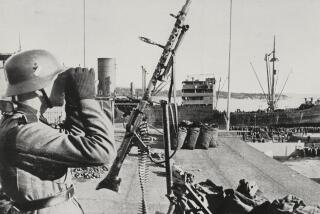Norway survivors recount island horror
- Share via
Reporting from Oslo — The gunman had already spared him once. It wasn’t going to happen again.
Minutes before, Adrian Pracon had been trying to swim to safety when he saw the killer point his weapon at him. “Please, no, please!” Pracon screamed. No bullet came.
Now, sprawled face down on a half-submerged rock, trying to play dead, the 21-year-old sensed the shooter standing almost directly above him, so close that he could feel the heat of the weapon.
As the gunman fired at other youths lying on the island’s shore, Pracon kept still, even when a bullet hit his shoulder. That apparently convinced the attacker that Pracon was dead and to move on.
“It was as though he had done this kind of thing before, as if going around and shooting people was totally normal,” Pracon told Norway’s Aftenposten newspaper. “He said, ‘You’re all going to die.’ ”
In harrowing accounts such as Pracon’s, the pieces of the blood-soaked drama Friday on Utoya Island began coming together as police pressed on with their investigation of the deadliest day on Norwegian soil since World War II, and found themselves on the defensive over how long it took to stop the carnage.
Authorities said Saturday that the death toll from twin attacks had reached 92, with 85 of the victims — mostly young people — killed in the rampage targeting a youth camp of the ruling Labor Party on Utoya. At least seven people died in a massive bomb blast that occurred shortly before in the center of Oslo. Four people are still missing.
Police said the suspected gunman, Anders Behring Breivik, described as a Christian fundamentalist with extreme right-wing views, put up no resistance when officers arrived on Utoya to apprehend him. He has admitted firing on hundreds of people gathered on the island outside Oslo for a summer retreat, police said.
It was a methodical massacre that went on, incredibly, for at least 60 minutes. Terrified youths were hunted down as they hid inside bathrooms, scrambled through bushes on the heavily wooded island and dived into the icy water to try to escape.
With a sniper’s calm, the gunman picked them off on land and in the water, using a handgun and an automatic weapon.
Even more frightening, he was dressed in a police uniform, which made some desperate survivors uncertain whether help or more hell had come when the real officers showed up.
“Who could we trust?” a survivor named Khamshajiny Gunaratnam wrote on her blog.
Breivik is also suspected of setting off the car bomb in Oslo. An agricultural cooperative reported Saturday that Breivik, 32, had ordered 6 metric tons of artificial fertilizer to be delivered in early May to his farmhouse in Asta, a sparsely populated community about 2 1/2 hours north of Oslo.
Because he owned a farm, the purchase seemed legitimate, though large, authorities said. But such fertilizer can also be used to make explosives, as was the case in the 1995 Oklahoma City bombing, carried out by antigovernment Army veteran Timothy McVeigh.
About 4 to 5 metric tons of fertilizer was found at Breivik’s farmhouse, Oslo Deputy Police Chief Sveinung Sponheim said. Investigators are trying to determine whether other bombs might be planted elsewhere.
Prime Minister Jens Stoltenberg said government workers were among the dead. The remains of some victims are still to be recovered from the heavily damaged buildings in downtown Oslo, police said.
Although the huge explosion appeared aimed at killing on a large scale, it also served as a diversion from — and a set-up for — the real slaughter to come on Utoya, less than an hour away from downtown Oslo.
Simen Mortensen, a volunteer for the summer camp, was stationed on the mainland side of the ferry service to Utoya. He told the Verdens Gang newspaper that a man wearing a police uniform and a bulletproof vest pulled up in a silver vehicle. The man was armed with a pistol and an automatic weapon with a telescopic lens.
“He gets out of the car and shows identification. Says he’s been sent to check on security, that this is routine, in connection with the terrorist attack,” Mortensen said. “Everything looks fine, and a boat is called to ferry him over to Utoya.
“After a few minutes, we hear shooting.”
Once on the island, the tall, blond man apparently beckoned unsuspecting campers over to him, telling them he wanted to talk about the explosion in Oslo.
News of the blast had already reached Utoya; the retreat’s leaders had called an informational meeting about it, so that attendees could call their families to make sure they were all right, Gunaratnam wrote in her blog.
Then the man drew his weapons and opened fire. Campers screamed and scattered.
“The first thing the crazy man did was shoot the first nice-looking girl he saw,” Marius Helander Roset told VG Nett, the online news site of Verdens Gang. Roset fled into the woods and hid behind a rock.
“We thought life was over while we ran. Many phoned home to give their parents a final message,” survivor Alexander Stavdal, 23, told VG Nett.
Several witnesses told journalists how the gunman mowed down bystanders in a hail of bullets, then coolly pulled out his pistol to finish off the wounded as they lay heaped on the ground.
Some campers dove into the frigid lake around the island. But the killer began shooting them too. Many of those who tried to swim to safety had to make the agonizing decision to turn back, their clothes too heavy for them to continue, or the distance to the mainland, about 500 yards, too far for them to cross.
Roset swam back to shore and found a cave to hide in with some others.
“The shooter was standing right near us and threw rocks into the water to lure us out,” he said.
Roset and others said the killer had an accomplice, a dark-haired man who was similarly armed but did not wear a police uniform.
Sponheim, the deputy police chief, said Saturday that investigators were looking into all possibilities.
But much of the focus remained on Breivik, who was described in some news reports as a loner.
On Saturday, a 1,500-page online book surfaced that appears to have been written by Breivik, under the Anglicized name Andrew Berwick, a rambling right-wing manifesto advocating violence to achieve “European independence.” The identity of the author could not be immediately confirmed.
“He has stated that it was cruel that he had to perform these actions, but in his mind it was necessary,” defense attorney Geir Lippestad told reporters as he left the police station late Saturday, Verdens Gang reported.
The police are being questioned about the length the response time to the rampage on Utoya. Sissel Hammer, the chief of police for the district covering Utoya, released a chronology late Saturday showing that special forces from Oslo took nearly 45 minutes to reach the island after her district called them for help. By then, an hour had elapsed since the first report of shooting on the island.
Asked why a helicopter wasn’t used, Sponheim said police had rejected the option because requisitioning the chopper would take longer than the journey by road.
When police arrived on the island, dozens of young people were already dying or dead. Officers shouted at the gunman to freeze and put down his weapons. He complied without resistance and without police firing a shot, bringing a mind-boggling massacre to a strangely meek end.
Police began rounding up trembling campers to assure them that they were safe. One said he was advised to keep his eyes down, “but it was impossible not to see that there were dead people all around us on all sides.”
In shock and in tears, campers were taken off the island and eventually reunited with family members who had gone through their own ordeal as they awaited word.
Gunaratnam, the blogger, said she was too numb to cry.
“We don’t deserve to die,” she wrote. “We’re just normal youth. We participate in politics. We want to make the world a better place. I missed the part where WE became the bad guys.”
Times staff writers Ann Simmons in Los Angeles and Janet Stobart in London contributed to this report.
More to Read
Sign up for Essential California
The most important California stories and recommendations in your inbox every morning.
You may occasionally receive promotional content from the Los Angeles Times.














